
Wheat varieties – how they differ and the impact on end-product
22 September 2021 | Kate Mackinson, Cereals and Ingredients Characterisation Manager
Consumers around the world are interested to try new foods from other countries and manufacturers are fulfilling that need.
For bakers who want to recreate bakery goods from other areas, the quality of the flour used may have a significant impact on the authenticity of the product produced. Baati is one such example. This hard and unleavened bread may often be seen complementing dishes in northern parts of India, but European-based bakers may find recreating it difficult when using their usual flour.
A variety of ingredients can be added to flours to adjust their properties but choosing a flour that’s more similar to that used in the country of origin will keep the ingredients list short and may reduce costs. Both outcomes are important to the consumer and meeting them starts with the wheat.
Particularity of wheat
Wheat is a unique grain in its ability to make the fully elastic dough required for leavened products. This is achieved from the gluten forming proteins it contains.
The grain is made of a succession of different layers (bran) protecting the endosperm and the germ. A particularity of the wheat is the presence of a crease that extends the full length of the grain and this complicates the process of separating the endosperm from the other layers during milling into flour.
Different species of wheat
Most flours used in baking processes are produced from naked, free threshing wheat varieties also known as common or bread wheat. Hulled wheats such as einkorn, emmer and spelt are also used in certain geographical areas, sometimes in significant quantities. Durum wheat, destined mostly for semolina and pasta production, is an important naked, free threshing wheat species and represents a significant proportion (around 5%) of the wheat crop. However, these species remain a minor part of global wheat production when compared to the common wheat that this article focuses on.
Different varieties of common wheat
Wheat varieties are often classed based on their:
- endosperm texture (hard or soft)
- sowing season (winter or spring), and
- seed coat colour (e.g. red, white).
The functionality of the gluten is also frequently used to differentiate wheat varieties.

Most flours used in baking are produced from naked, free threshing wheat varieties also known as common or bread wheat.
Endosperm texture
Kernel hardness is related to the force needed to crush the wheat when milling and flour functionality is partly influenced by this parameter. The reason is that hard and soft wheat behave differently upon milling. Hard wheat breaks cleanly along the endosperm cell walls or across starch granules leading to a granular flour that flows easily and sieves quickly. In soft wheat however, the starch granules are not held as tightly in the protein matrix. As a result, the breaks occur at the points of weakness within the cells which lead to irregular, rough particles. Free starch granules are released, the flour is dusty, flows less easily and is more difficult to sieve.
The separation of the endosperm and bran is usually easier in hard wheat than soft wheat leading to higher extraction rates in the former. For bread products and similar leavened dough products, flours from hard wheat are preferred. For biscuits, cookies and cake products, flours from soft wheat are usually preferred.
Seasonality
Some wheat varieties require a low-temperature period after initial germination, also called vernalisation, to develop and thrive. These varieties are usually sown in early autumn and potentially up to early winter. They are known as winter wheats. Other varieties do not require this vernalisation step and are known as spring wheat varieties. These are grown in different geographies - particularly in areas that endure harsh winters that are too cold for the winter wheats. Their yield, however, is usually lower than the winter wheat varieties.
Seed coat colour
The colour of the seed coat is determined genetically and impacts on some of the wheat variety characteristics. In particular, a higher level of red pigmentation has been linked to a longer dormancy period after ripening. As a result, red varieties are more suited than white varieties to climates with wet ripening and harvest seasons where the latter may suffer from pre-harvest sprouting and low Hagberg falling numbers.
The quantity and quality of a wheat’s proteins determine whether it will behave as a strong or weak wheat.
Gluten strength
The quantity and quality of a wheat’s proteins determine whether it will behave as a strong or weak wheat. As water and flour are mixed, the flour proteins swell, stretch and rearrange themselves into an organised, cohesive and continuous network that plays a major role in gas retention for leavened dough products. Strong wheats are used for bread flours and various other leavened dough products. The gluten in these wheats is mostly elastic with a good balance of extensibility. Weak wheats are used for applications such as biscuits and cakes. Their gluten is mostly extensible and balanced with some elasticity.
Breeding new varieties
Human intervention for the purpose of improving wheat agronomics and quality is a concept that has been around for a long time. The process has evolved greatly and is now very targeted and systematic. New wheat varieties are often subject to rigorous trials to assert their yield potential, milling quality and disease and pest resistance.
With the increase in population and consumption, an increase in yields of crops including wheat has been a drive for several decades. The need for increased sustainability and environment protection has also put renewed focus on increasing disease-, pest- and extreme weather-resistance whilst retaining or improving technological quality and reducing the need for agricultural inputs. Striking this fine balance is the difficult task facing wheat breeders.
Once the parent varieties are chosen, crosses are made followed by selection of the plants in the resulting progeny. In the early stages, this may be done based on morphology, pathogen resistance and yield. More recently, the presence or absence of specific DNA markers related to genetic traits are also used for selection and can be useful in the early stages when a limited amount of grain is available for testing and several hundreds of plants need to be assessed. In the latter stages of a variety’s breeding process, when a larger amount of grain is available, flour functionality and technological quality will also be assessed.
Flour quality and functionality
Depending on the application, different flour characteristics are required - some of which will be very specific to the product. Flour functionality depends on a number of parameters and the main ones are determined by the proteins’ or starch characteristics.
Protein characteristics
Protein content remains an important parameter for wheat trading, variety classification and in flour specifications. Broadly, the wheat flour contains two types of proteins:
- soluble proteins (including albumins and globulins), and
- insoluble proteins (including the gluten forming gliadins and glutenins).
The gluten quality is determined partly by the wheat variety. However, it is also affected by growing conditions (e.g. soil, weather conditions) and storage of the wheat and flour. Since the protein quantity and quality is distributed heterogeneously within the grain and endosperm, the milling process can also influence these two parameters in the flour.
The protein quality affects the rheology and mixing properties of the dough and, by extension, its processing behaviour. The glutenins are related to dough elasticity and the gliadins to dough extensibility. The gluten development characteristics, behaviour upon mixing and dough deformation under stress are very important for leavened products, such as bread. This is because an appropriate balance of elasticity and extensibility is required to allow the gas cells to expand during proofing and to retain this newly formed structure. In leavened products, higher protein content from hard wheat varieties has generally been linked to an increase in specific volumes and improvement in crumb texture. In some biscuits, an increase in protein levels has been linked with an increase in hardness. Soft wheats with lower protein content, lower elasticity and higher extensibility are generally used for these applications.
What about starch?
Starch is the main component of the wheat grain and presents itself in two forms: amylose (a straight chain molecule) and amylopectin (a complex branched molecule). The ratio between amylose and amylopectin content has a significant effect on the interactions between water and starch, and its gelling and pasting behaviour. Over a specific temperature range, gelatinisation occurs leading to granule swelling, loss of crystallinity and an intake of water.
The starch granules contained within the wheat grain are damaged during the milling process. The amount of potential starch damage is related to kernel hardness and is partly genetically determined. Starch damage affects water absorption since around four times more water is absorbed by damaged starch than by native starch. For bread products and the like, an increase in starch damage provides the potential for higher water absorption, improved gluten development, and larger product yields. It also increases the starch’s susceptibility to amylase digestion and, in doing so, provides a substrate for the yeast to feed on during the fermentation process. For biscuits, however, lower water absorption is preferred hence soft wheat with lower starch damage is often used.
Our team at Campden BRI has long been involved in the assessment of new cereals varieties for many years. With long-standing experience in the analysis of cereals and flour for milling quality and technological potential, our experts have helped manufacturers understand the characteristics their flours need for consistent end-product quality under optimised processing conditions. If this is something that you need help with, or if you have other wheat-related issues, do get in touch – we’d love to help.
Understand baked products better with our baking courses
From baking basics to biscuits and beyond - take a look at the full range of high quality training that’s delivered by our experts to develop and grow your workforce‘s skills and talents.
Kate Mackinson
+44(0)1386 842181
kate.mackinson@campdenbri.co.uk
This article was first published by Asia Pacific Baker & Biscuit.
How can we help you?
If you’d like to find out more about how we can help you with your wheat based products, contact our support team.
Become a member for support with your products
There are many benefits to becoming a member of Campden BRI. Find out what these are and join us today.






